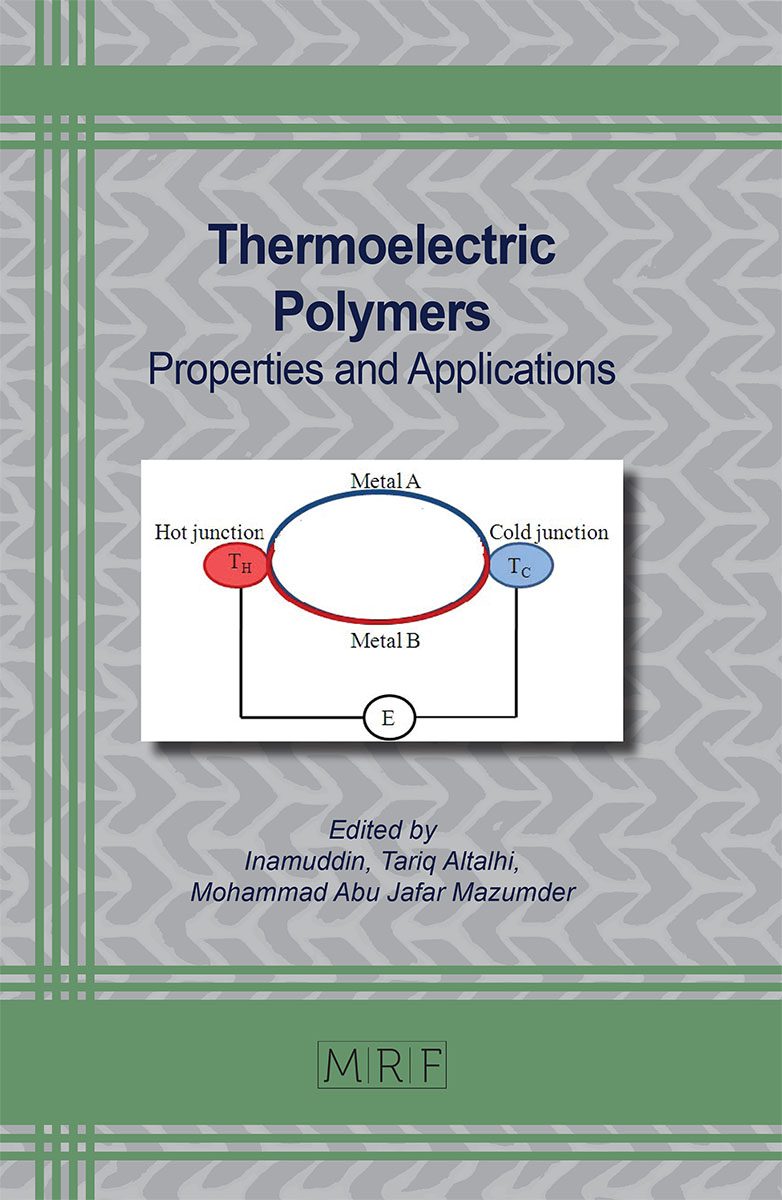Materials used in Thermoelectric Polymers
Muhammad Khalil, Sana Kainat, Maria Wasim, Aneela Sabir, Muhammad Shafiq
Nowadays, Polymer based thermoelectric (TE) materials are gaining more and more attention from researchers because of their easy processability, low thermal conductivity, and low cost. These polymers contain conjugation in their structure which helps to conduct electricity through them. Common thermoelectric materials contain conducting polymers and inorganic dopants. The resulting thermoelectric material may be of n-type or p-type. Their properties depend upon the morphology of matrix material, the concentration of charge carriers, and dopants… In this chapter, different types of conducting polymers (CE) and their derivatives, synthesis, properties, and factors affecting the properties of CE will be discussed.
Keywords
Thermoelectric Polymers, Conducting Polymers
Published online 2/10/2024, 12 pages
Citation: Muhammad Khalil, Sana Kainat, Maria Wasim, Aneela Sabir, Muhammad Shafiq, Materials used in Thermoelectric Polymers, Materials Research Foundations, Vol. 162, pp 69-80, 2024
DOI: https://doi.org/10.21741/9781644903018-4
Part of the book on Thermoelectric Polymers
References
[1] Y.J. Zeng, D. Wu, X.H. Cao, W.X. Zhou, L.M. Tang, K.Q. Chen, Nanoscale organic thermoelectric materials: Measurement, theoretical models, and optimization strategies, Adv. Funcn. Mater. 30 (2020) 1903873. https://doi.org/10.1002/adfm.201903873
[2] M. Dargusch, W.D. Liu, Z.G. Chen, Thermoelectric generators: Alternative power supply for wearable electrocardiographic systems, Adv. Sci. 7 (2020) 2001362. https://doi.org/10.1002/advs.202001362
[3] R. Kroon, D.A. Mengistie, D. Kiefer, J. Hynynen, J.D. Ryan, L. Yu, C. Müller, Thermoelectric plastics: From design to synthesis, processing and structure-property relationships, Chem. Soc. Rev. 45 (2016) 6147-6164. https://doi.org/10.1039/C6CS00149A
[4] C. Di, W. Xu, D. Zhu, Organic thermoelectrics for green energy, Natl. Sci. Rev. 3 (2016) 269-271. https://doi.org/10.1093/nsr/nww040
[5] J.L. Bredas, S.R. Marder, The WSPC Reference on Organic Electronics: Organic Semiconductors, 2016, World Scientific, p. 277-298. https://doi.org/10.1142/9678-vol1
[6] D. Nilsson, M. Chen, T. Kugler, T. Remonen, M. Armgarth, M. Berggren, Bi‐stable and dynamic current modulation in electrochemical organic transistors, Adv. Mater. 14 (2020) 51-54. https://doi.org/10.1002/1521-4095(20020104)14:1<51::AID-ADMA51>3.0.CO;2-#
[7] J.M. Zhuo, L.H. Zhao, R.Q. Png, L.Y. Wong, P.J. Chia, J.C. Tang, S. Sivaramakrishnan, M. Zhou, E.C.W. Ou, S.J. Chua, Direct spectroscopic evidence for a photodoping mechanism in polythiophene and poly (bithiophene‐alt‐thienothiophene) organic semiconductor thin films involving oxygen and sorbed moisture, Adv. Mater. 21 (2009) 4747-4752. https://doi.org/10.1002/adma.200901120
[8] B. Hamadani, D. Corley, J.W. Ciszek, J. Tour, D. Natelson, Controlling charge injection in organic field-effect transistors using self-assembled monolayers, Nano Lett. 6 (2006) 1303-1306. https://doi.org/10.1021/nl060731i
[9] A.B. Kaiser, Systematic conductivity behavior in conducting polymers: Effects of heterogeneous disorder, Adv. Mater. 13 (2001) 927-941. https://doi.org/10.1002/1521-4095(200107)13:12/13<927::AID-ADMA927>3.0.CO;2-B
[10] D.X. Crispin, Retracted article: Towards polymer-based organic thermoelectric generators, Ener. & Env. Sci. 5 (2012) 9345-9362. https://doi.org/10.1039/c2ee22777k
[11] B.T. McGrail, A. Sehirlioglu, E. Pentzer, Polymer composites for thermoelectric applications, Angew. Chem. Int. Ed. 54 (2015) 1710-1723. https://doi.org/10.1002/anie.201408431
[12] C.J. Yao, H.-L. Zhang, Q. Zhang, Recent progress in thermoelectric materials based on conjugated polymers, Polymers. 11 (2019) 107. https://doi.org/10.3390/polym11010107
[13] H. Yan, N. Sada, N. Toshima, Thermal transporting properties of electrically conductive polyaniline films as organic thermoelectric materials, J. Therm. Anal. Calorim. 69 (2002) 881-887. https://doi.org/10.1023/A:1020612123826
[14] X. Guan, E. Yildirim, Z. Fan, W. Lu, B. Li, K. Zeng, S.-W. Yang, J. Ouyang, Thermoelectric polymer films with a significantly high Seebeck coefficient and thermoelectric power factor obtained through surface energy filtering, J. Mater. Chem. A. 8 (2020) 13600-13609. https://doi.org/10.1039/D0TA05324D
[15] N. Dubey, M. Leclerc, Conducting polymers: Efficient thermoelectric materials, J. Polym. Sci. Part B: Polym. Phys. 49 (2011) 467-475. https://doi.org/10.1002/polb.22206
[16] Y. Du, S.Z. Shen, K. Cai, P.S. Casey, Research progress on polymer-inorganic thermoelectric nanocomposite materials, Prog. Polym. Sci. 37 (2012) 820-841. https://doi.org/10.1016/j.progpolymsci.2011.11.003
[17] M. Bharti, A. Singh, S. Samanta, D. Aswal, Conductive polymers for thermoelectric power generation, Prog. Mater Sci. 93 (2018) 270-310. https://doi.org/10.1016/j.pmatsci.2017.09.004
[18] M.A. Kamarudin, S.R. Sahamir, R.S. Datta, B.D. Long, M.F.M. Sabri, S.M. Said, A review on the fabrication of polymer-based thermoelectric materials and fabrication methods, Sci. World J. 713640 (2013) 1-17. https://doi.org/10.1155/2013/713640













